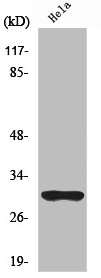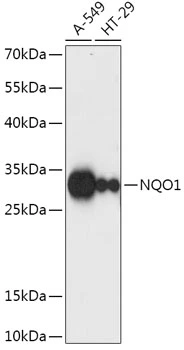NQO1 antibody [C2C3], C-term
GTX100235
ApplicationsImmunoFluorescence, Western Blot, ImmunoCytoChemistry, ImmunoHistoChemistry, ImmunoHistoChemistry Paraffin
Product group Antibodies
TargetNQO1
Overview
- SupplierGeneTex
- Product NameNQO1 antibody [C2C3], C-term
- Delivery Days Customer9
- Application Supplier NoteWB: 1:500-1:3000. ICC/IF: 1:100-1:1000. IHC-P: 1:100-1:1000. *Optimal dilutions/concentrations should be determined by the researcher.Not tested in other applications.
- ApplicationsImmunoFluorescence, Western Blot, ImmunoCytoChemistry, ImmunoHistoChemistry, ImmunoHistoChemistry Paraffin
- CertificationResearch Use Only
- ClonalityPolyclonal
- Concentration0.61 mg/ml
- ConjugateUnconjugated
- Gene ID1728
- Target nameNQO1
- Target descriptionNAD(P)H quinone dehydrogenase 1
- Target synonymsDHQU, DIA4, DTD, NMOR1, NMORI, QR1, NAD(P)H dehydrogenase [quinone] 1, DT-diaphorase, NAD(P)H dehydrogenase, quinone 1, NAD(P)H-quinone oxidoreductase, NAD(P)H:Quinone acceptor oxidoreductase type 1, NAD(P)H:menadione oxidoreductase 1, NAD(P)H:quinone oxidoreductase 1, NAD(P)H:quinone oxireductase, azoreductase, diaphorase (NADH/NADPH) (cytochrome b-5 reductase), diaphorase-4, dioxin-inducible 1, menadione reductase, phylloquinone reductase, quinone reductase 1
- HostRabbit
- IsotypeIgG
- Protein IDP15559
- Protein NameNAD(P)H dehydrogenase [quinone] 1
- Scientific DescriptionThis gene is a member of the NAD(P)H dehydrogenase (quinone) family and encodes a cytoplasmic 2-electron reductase. This FAD-binding protein forms homodimers and reduces quinones to hydroquinones. This proteins enzymatic activity prevents the one electron reduction of quinones that results in the production of radical species. Mutations in this gene have been associated with tardive dyskinesia (TD), an increased risk of hematotoxicity after exposure to benzene, and susceptibility to various forms of cancer. Altered expression of this protein has been seen in many tumors and is also associated with Alzheimers disease (AD). Alternate transcriptional splice variants, encoding different isoforms, have been characterized. [provided by RefSeq]
- Storage Instruction-20°C or -80°C,2°C to 8°C
- UNSPSC12352203
References
- Lu YU, Miyamoto T, Takeuchi H, et al. PPARα activator irbesartan suppresses the proliferation of endometrial carcinoma cells via SREBP1 and ARID1A. Oncol Res. 2023,31(3):239-253. doi: 10.32604/or.2023.026067Read this paper
- Lai W, Li D, Wang Q, et al. Bacterial Magnetosomes Release Iron Ions and Induce Regulation of Iron Homeostasis in Endothelial Cells. Nanomaterials (Basel). 2022,12(22). doi: 10.3390/nano12223995Read this paper
- Ren J, Zhang S, Wang X, et al. MEF2C ameliorates learning, memory, and molecular pathological changes in Alzheimer’s disease in vivo and in vitro. Acta Biochim Biophys Sin (Shanghai). 2022,54(1):77-90. doi: 10.3724/abbs.2021012Read this paper
- Chao TY, Hsieh CC, Kuo YH, et al. Bracteanolide A abrogates oxidative stress-induced cellular damage and protects against hepatic ischemia and reperfusion injury in rats. Food Sci Nutr. 2021,9(9):4758-4769. doi: 10.1002/fsn3.2374Read this paper
- Hori Y, Tsutsumi R, Nasu K, et al. Aromatic-Turmerone Analogs Protect Dopaminergic Neurons in Midbrain Slice Cultures through Their Neuroprotective Activities. Cells. 2021,10(5). doi: 10.3390/cells10051090Read this paper
- Kuang Y, Zhang Y, Xiao Z, et al. Protective effect of dimethyl fumarate on oxidative damage and signaling in cardiomyocytes. Mol Med Rep. 2020,22(4):2783-2790. doi: 10.3892/mmr.2020.11342Read this paper
- Lin DS, Ho CS, Huang YW, et al. Impairment of Proteasome and Autophagy Underlying the Pathogenesis of Leukodystrophy. Cells. 2020,9(5). doi: 10.3390/cells9051124Read this paper
- Huang SY, Chang SF, Chau SF, et al. The Protective Effect of Hispidin against Hydrogen Peroxide-Induced Oxidative Stress in ARPE-19 Cells via Nrf2 Signaling Pathway. Biomolecules. 2019,9(8). doi: 10.3390/biom9080380Read this paper
- Wu CT, Deng JS, Huang WC, et al. Salvianolic Acid C against Acetaminophen-Induced Acute Liver Injury by Attenuating Inflammation, Oxidative Stress, and Apoptosis through Inhibition of the Keap1/Nrf2/HO-1 Signaling. Oxid Med Cell Longev. 2019,2019:9056845. doi: 10.1155/2019/9056845Read this paper
- Cai J, Pires KM, Ferhat M, et al. Autophagy Ablation in Adipocytes Induces Insulin Resistance and Reveals Roles for Lipid Peroxide and Nrf2 Signaling in Adipose-Liver Crosstalk. Cell Rep. 2018,25(7):1708-1717.e5. doi: 10.1016/j.celrep.2018.10.040Read this paper


![ELISA analysis of antigen using GTX60523 NQO1 antibody [4D12]. Black : Control antigen 100ng Purple : Antigen 10ng Blue : Antigen 50ng Red : Antigen 100ng](https://www.genetex.com/upload/website/prouct_img/normal/GTX60523/GTX60523_20170912_ELISA_w_23061123_645.webp)
![ELISA analysis of antigen using GTX60524 NQO1 antibody [1A11]. Black : Control antigen 100ng Purple : Antigen 10ng Blue : Antigen 50ng Red : Antigen 100ng](https://www.genetex.com/upload/website/prouct_img/normal/GTX60524/GTX60524_20170912_ELISA_w_23061123_544.webp)


